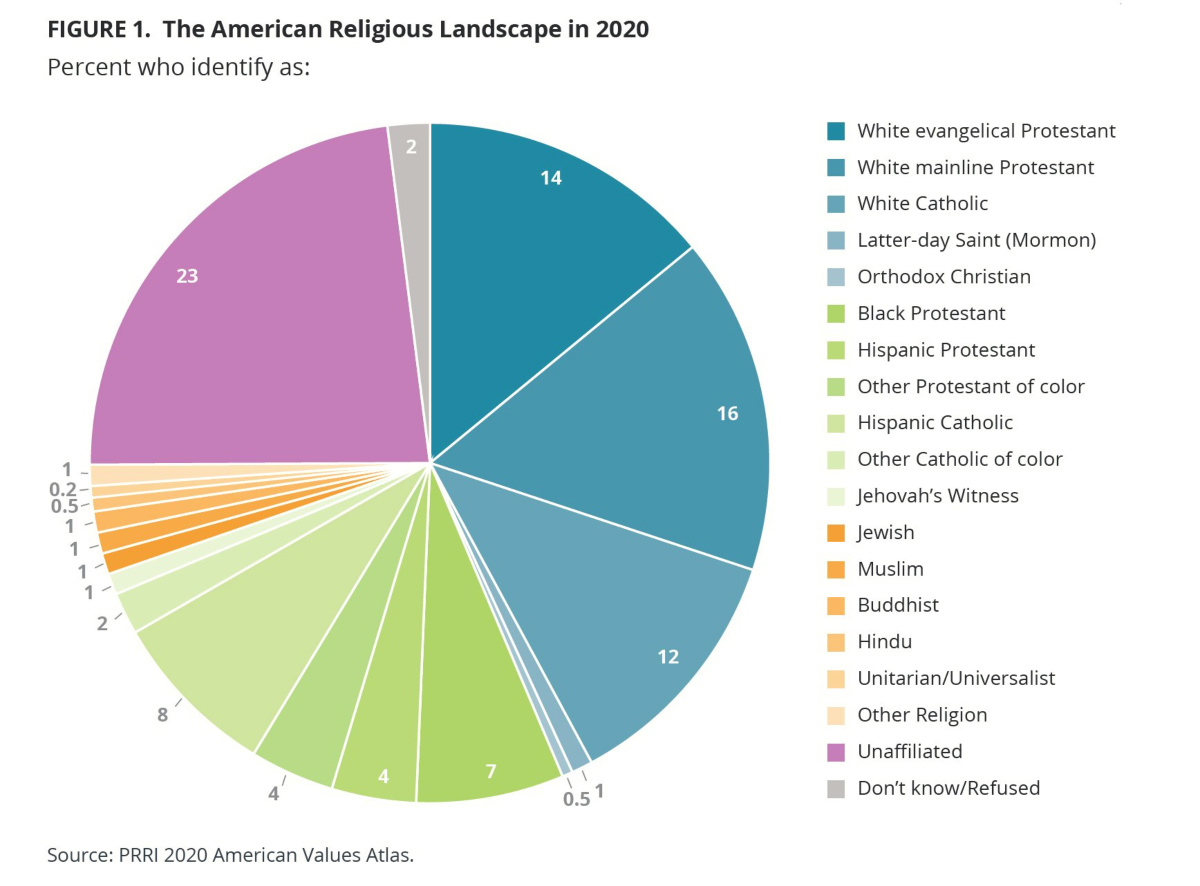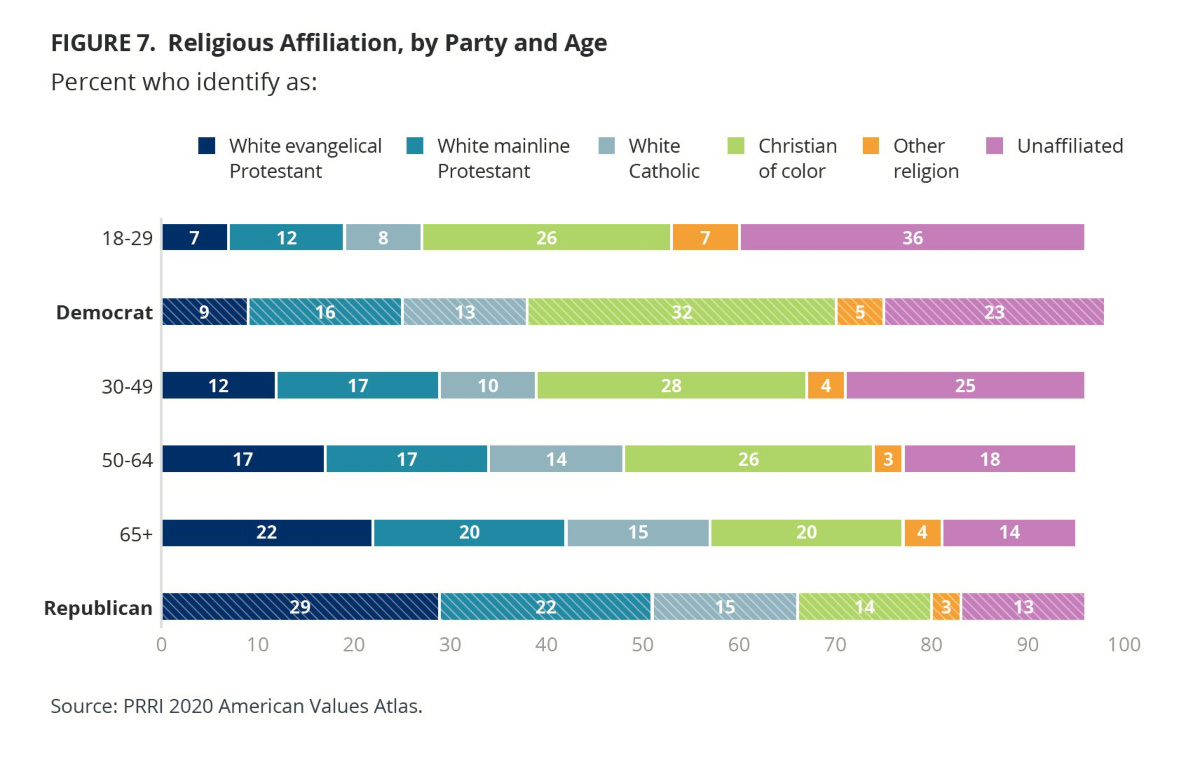White Christian decline has slowed. Mainline Protestants now outnumber white evangelicals. New York is home to several of the most religiously diverse counties in the US.
These shifts and findings are among some of the notable revelations documented in a sweeping and exhaustive survey of the US religious landscape by the Public Religion Research Institute.
The 2020 Census of American Religion, released on Thursday, is based on what researchers called an “unprecedented” dataset that includes hundreds of thousands of respondents surveyed between 2013 and 2019.

Clergy and other faith leaders will be perhaps most interested in PRRI’s finding that religiously unaffiliated Americans, or “nones” in religion demography parlance, have lost ground, making up just 23 per cent of the country. The complex group – which includes atheists, agnostics and some people who say they pray daily but don’t claim a specific faith tradition – peaked at 25.5 per cent of the population in 2018.
White Christians, meanwhile, have expanded their share of the population, particularly white mainline Protestants. That group sits at 16.4 per cent, an increase from 13 per cent in 2016, whereas white evangelicals – who PRRI delineated from white mainliners using a methodology researchers said is commonly utilised by major pollsters – now represent about 14.5 per cent of the population, down from a peak of 23 per cent in 2006. White Catholics now hover around 11.7 per cent, up from a 2018 low of 10.9 per cent.
The percentage of white Christians ticked up overall, rising from 42 per cent in 2018 to 44 per cent in 2020.
PRRI CEO Robert Jones said in an email that the survey doesn’t provide precise explanations regarding the shift among white Christians. But he pointed to “circumstantial evidence” that suggests “over the last two years in particular, white mainline Protestants seem to have absorbed at least some folks leaving white evangelical and other churches who may have otherwise landed in the religiously unaffiliated camp.”
Even with these small gains, however, white Christians have shrunk dramatically as a proportion of the population over the past few decades, having represented 54 per cent of the population as recently as 2006.
And the political power of unaffiliated Americans continues to grow. Mainliners represent the same percentage of each political party in 2020 as they did in 2006 — 22 per cent of Republicans, 16 per cent of Democrats. They are also politically split three ways: According to the report, 33 per cent identify as Republican, 35 per cent identify as Democrat, and 30 per cent identify as independent. By contrast, the percentage of unaffiliated Americans has expanded in both parties: They now represent 23 per cent of Democrats (compared with just nine per cent in 2006) and 13 per cent of Republicans (compared with four per cent).
Further complicating the political calculus are the ages of each faith community. White evangelicals are now the oldest religious group, with a median age of 56. White mainliners and Black Protestants share the same median age – 50 – with white Catholics skewing closer to evangelicals at 54.
The youngest religious Americans are Muslims, with a median age of just 33. They’re followed by Hindus and Buddhists (both 36), unaffiliated Americans (38), Hispanic Protestants (39) and Hispanic Catholics (42). Jewish Americans (48) and members of The Church of Jesus Christ of Latter-day Saints (47) make up the middle of the pack alongside Jehovah’s Witnesses (49) and Orthodox Christians (42).

The survey noted that most religious groups have seen their median ages increase, with the exception of Jewish Americans and white mainliners. Jones pointed to the mainline median age – which has actually decreased since 2013, when it was 52 – as more evidence mainline churches may be taking in people disaffiliating from other religious groups, who he said “tend to be younger.”
Meanwhile, Christians of colour have increased as a proportion of the population, rising from 23 per cent in 2006 to 26 per cent in 2020. They are also collectively the largest religious group among Democrats (32 per cent), but make up a much smaller percentage of Republicans (14 per cent).
The survey was able to tease out granular county-level data for religious groups, drawing from a dataset of 460,000 responses that Jones said “provides the most detailed estimates of American religious affiliation since the US Census Bureau last collected religious affiliation data in 1957.”
That included a list of the most religiously diverse counties in the US: Brooklyn and Queens in New York took the top two spots, followed by Montgomery County, Maryland, and Navajo County, Arizona.
The least religiously diverse counties were mostly in Mississippi – namely, Noxubee and Panola counties – with Conecuh County, Alabama, rounding out the top three.
Alabama was also home to the county with the highest percentage of white evangelicals (Marion County, with 64 per cent), with Holmes County, Mississippi, claiming the highest percentage of Black Protestants (68 per cent). Pope County, Minnesota, was found to have the highest concentration of white mainliners (37 per cent), and Dubuque, Iowa, claimed the same for white Catholics (45 per cent).
Hispanic Protestants were most represented in Hidalgo County, Texas (21 per cent), with nearby Zapata County boasting the same for Hispanic Catholics (59 per cent). The highest concentration of other Christians – which includes multi-racial Christians, Native American Christians, Black Catholics, and Christians who are Asian American or Pacific Islander – is found in Oglala Lakota County, South Dakota (44 per cent).
Researchers reported the highest concentration of Jewish Americans in Rockland County, New York (18 per cent), Muslim Americans in Queens County (five per cent), Buddhists in Hawaii’s Maui and Hawaii counties (five per cent each), and Hindus in Middlesex County, New Jersey (seven per cent).
Religiously unaffiliated Americans are most concentrated in San Juan County, Washington (49 per cent), and all of the counties with the highest concentration of Latter-day Saints were in Utah, with one exception: Madison County, Idaho (68per cent), which placed second in that list.






